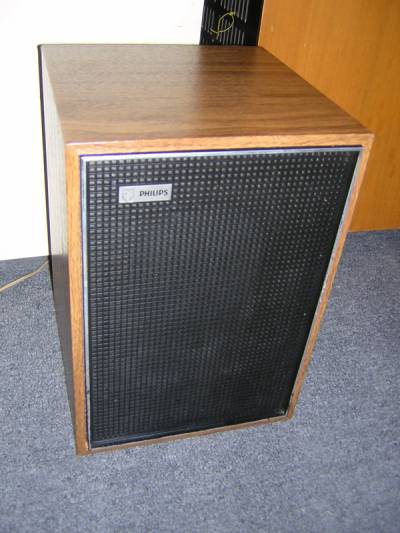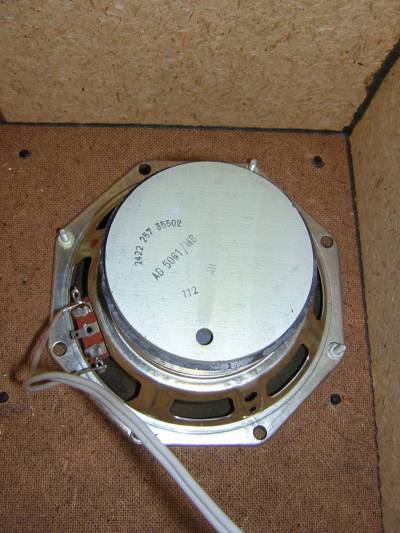Philips 22RH481 (1968)

| Philips Luidsprekerbox |
22RH481
Nr; PL 77163 & 77164
|
| Vermogen |
9 Watt (6W muziek) 8 Ohm |
| Luidspreker |
5" Breedband
Type AD5061/M8
|
| Frequentie bereik |
60-16.000 Hz |
| Kast |
Plastic front houten kast
BxHxD 280x280x200
7 Liter |
| info |
Standaard geleverd bij o.a. de 22RH786
receiver |
| In de colectie |
juli 2005 |
De breedband luidspreker AD5061 M8.
5 inch, 8 hoekig met papier dome en extra hoge tonen "Wizzer
cone".

Whizzer Cones
by MG (from a Full Range Forum post)
Full-range Driver & Loudspeaker Theory
Full-range (or wide-range) drivers come in two general types: the center cap and the whizzer cone. The center cap type looks like your normal cone speaker with a dome center cap. The whizzer cone type has two cones, a large cone (as in normal cone speakers) and a smaller whizzer cone inside the large cone.
Whizzer cones were originally an afterthought to extend the high frequency response of midrange cones. Midrange paper cones absorb the flexural wave as it travels out from the voice coil. This means that there is a reduction in radiating area and high frequency response. Since the wave speed is proportional to the square root of frequency this usually ends up being a 1st order roll off, but please don't ask me to explain this in detail in a simple posting!
The midrange of paper cones can be extended by flaring the cone, so that the centre is mildly horn loaded, this gets you up to about 5kHz. The whizzer is flared to fit inside the main cone, and can sometimes be be used to horn load the area between the whizzer and the cone. Normal DIY practice is to fiber wool fill this region to avoid higher frequency cancellation.
By being light and stiff, the whizzer does not greatly affect the working of the main cone, the flexural wave traveling out from the voice coil pretty much unattenuated. This means that the high frequency can now be radiated over a much larger area, and hence the response is extended. The front of the whizzer does not horn load the centre, although the shape will affect high frequency dispersion.
Since the whizzer is unconstrained around the edges some cone modes can occur, although half roll surrounds do not damp these out as much as people would like to believe. The best trick for this is to silicon fluid damp both paper cones - since the whizzer is much thinner it will absorb much less silicon fluid, so its high frequency response will not be greatly attenuated. Critical damping of the spider is also very successful at eliminating these, but can increase the mechanical damping Qms parameter.
Understanding of diaphragm flexure has led to a new generation of whizzer-less full range designs, the pinnacle being the Jordan JX series. For my money these represent the ultimate cone flexure technology, but there are many other available drivers. Increasing practice is to use the same passive electrical network, used for baffle step correction, to extend the high frequency response - although this is limited to about 1/2 an octave.